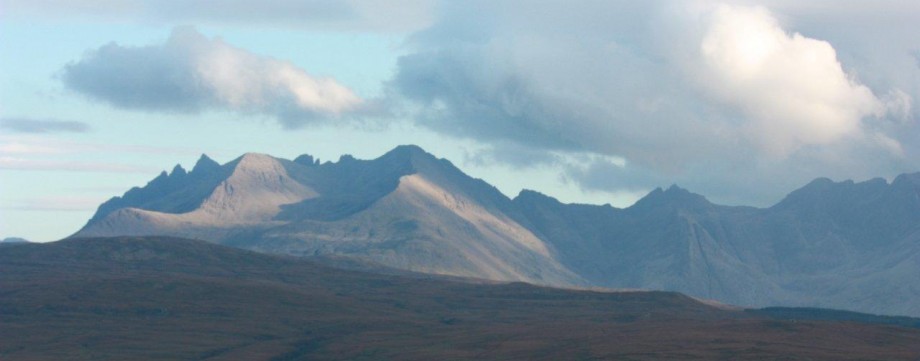Just north of Barra lies the little chain of islands called The Uists, all connected by causeway. These beautiful islands lie between Barra and the larger island of Harris and Lewis.

a wee Eriskay pony
On our way to our next home, we drove through Eriskay, the smallest island in the Hebrides. It’s known for a few things, some more famous than others. This is the land where Bonnie Prince Charlie first set foot in Scotland landing on a beach now called the Prince’s Strand. Eriskay has its own ponies, much like Shetland ponies only perhaps more potbellied. It’s also known for the sinking of the S.S. Politician, a ship that was loaded with 250,000 bottles of whiskey, which the inhabitants of the island valiantly saved – and drank. (The tale is commemorated in the book Whisky Galore, by Colum MacKenzie and a movie of the same name, which we are going to see this week.)

the altar at St. Michael’s
And finally, Eriskay is known for St. Michael’s Church. This church has a unique altar: it’s made up of the prow of a rescue boat, it’s a beautiful tribute to a place that’s tied to the sea. We had a fantastic chat with Father Ross, who speaks fluent Gaelic, English and French (and apparently several other languages.)

Our that-roofed cottage in Benbecula
We learned that when you travel between these islands, you go “down north” and “up south”. We don’t know why but that’s what we were told, so that’s what we did: we left Eriskay and headed down north to Benbecula. This was described to us as “no man’s land” – what lies between South and North Uist. It marks the space between the Catholic south and the Protestant north. Our home was a traditional thatch-roofed cottage, owned by Niall (Neil) Campbell who works for Gallic Media. The cottage was his family home growing up, later became dilapidated, and has been restored to be used as a vacation rental. It’s fantastic. It’s also well situated as a home base while exploring the area.
Benbecula is a lovely little island that has the benefit (or curse, depending on who you ask) of supporting a military base, which means it has a great grocery store, a petrol station and an airport. It also has an amazing beach – where we found the shipwreck that John mentioned in our last post.

Our Lady of the Isles
In South Uist, we visited the elegant statue of Our Lady of the Isles. She’s beautiful, holding her baby Jesus up high so that he can bless all that’s around them. She’s also a huge reminder that you’re in Catholic country.

Grey Heron, fishing.
We went looking for Loch Druidibagh to see if we could find the Red Necked Phalarope or the Red Throated Diver. We thought we were going to find an RSPB hut with a person in it who would tell us more but there was no such thing so, without meaning to, we drove right past it to Loch Sgioport. Since we were there, we chose to hike the hills and had lunch at the ruin of a cottage overlooking the secluded loch. The sun shone and it was wonderfully quiet. On our way back, we found Loch Druidibagh and walked for a long way on its well-built board walk but alas, by then it was so windy, no birds were out and about. On our way home, we stopped for well-earned tea and cake at the café in the Hebridean Jewellery shop. Leaving here, we experienced what we so often do when traveling Scotland: we found what we didn’t even know we were looking for. The café is situated at the sea and John spotted a Grey Heron on a beach between two grassy knolls. We stopped the car to take his picture, then went for a walk and saw so many birds: ringed plovers, oyster catchers and black-capped gulls. It was a great end to a beautiful day.

this panorama shows you just some of the surrounding lakes
North Uist is described as “half-drowned in lochs” and it’s true. There’s more water than there is land. We visited the excellent museum in Lochmaddy with its focus on life by the sea and which also had an excellent exhibit of artwork from the North Uist Fine Arts School. We then headed out to the RSPB Reserve at Balranald. What a fantastic place! We walked along a well-marked trail along the “machair”: grassland along the sea that is abloom with wildflowers like poppies, bog cotton, buttercup, and more. We saw all kinds of sea and shore birds, and were happily taking photos when the rain began.

these are poppies on the machair, there’s no photo of gale force winds or us soaking wet because we were protecting the camera!
Oh. My. Gosh. I don’t even know if it was raining all that hard but the WIND. Unreal. It blew the rain right through most of our clothes. By the time we got back to our car we were dripping but grateful for a warm car, a warm home to go to and, as John said, grateful even for the ability to be able to do what we are doing. I think what we re-learn each time we do a trip like this is that the destination isn’t as important as the journey itself. What is truly important is what lies between where you start and where you’re going.










